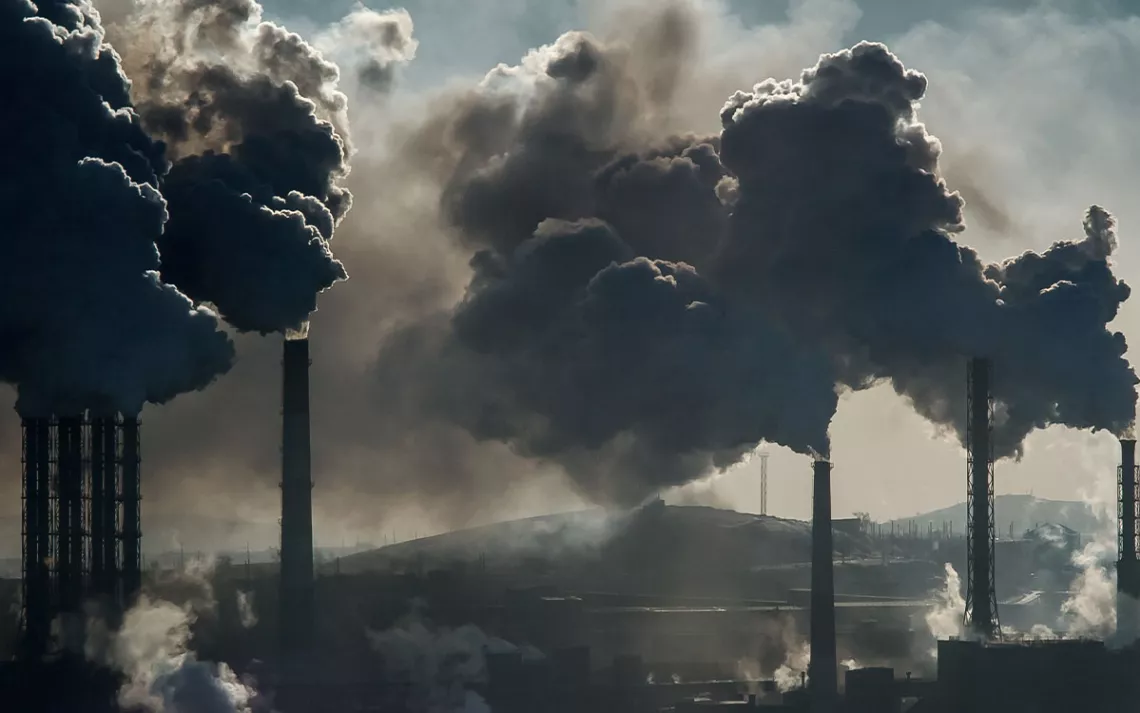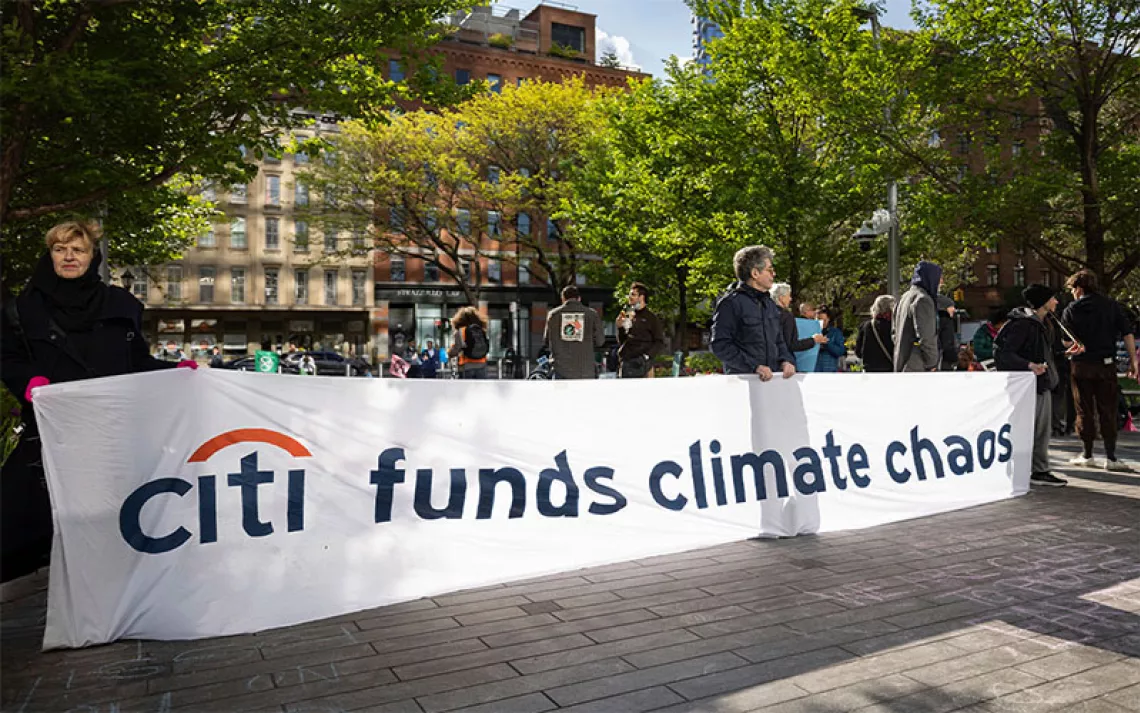Banks Use “Net Zero by 2050” as a Smoke Screen to Conceal Support for Dirty Coal
A new report reveals how the biggest banks are propping up the fossil fuel status quo

Like many of the biggest financial institutions, the British multinational bank Barclays dedicates a section of its website to acknowledging the reality of climate change and the need to act in response. On a page featuring a riparian green landscape, the bank promotes a commitment to net zero by 2050 and calls climate change “an urgent and complex challenge that demands a fundamental transformation of the global economy.”
That urgent challenge is one the bank is apparently waiting for someone else to take on. According to new research, Barclays tops the list of the biggest financial institutions propping up polluting coal plants in the United States. Since the adoption of the Paris Agreement in 2015, the bank has shoveled a whopping $17.7 billion to the parent companies of those operations.
It’s not the only one. A new report, Lethal Investments: The Health and Consequences of Cash Flows Into Coal, released by the Sierra Club’s Fossil-Free Finance Campaign, reveals that six banks—Barclays, JPMorgan Chase, Bank of America, Citi, Wells Fargo, and Mitsubishi UFJ (MUFG)—have poured $83.8 billion into 10 parent companies that operate coal plants. Overall, financial institutions have injected $166 billion into that coal network since 2016—a direct expression of support for fossil fuels from the global monetary system.
As the planet reels from the hottest summer months ever recorded, the new report paints a stark picture: In many cases, the “net zero by 2050” commitment intended to limit average global temperature rise to 1.5°C, and thereby arrest the climate crisis, is a mirage banks publicly wield to greenwash their image. Meanwhile, privately, they protect and prop up the fossil fuel status quo directly causing that crisis.
“Most major banks are not meeting the moment we’re in,” Adele Shraiman, senior campaign strategist for Fossil-Free Finance, Sierra Club, told Sierra. “Even in cases where the banks that have started to take steps in the right direction—most of their policies have glaring loopholes or massive gaps, which leave billions of dollars on the table for the most polluting industries."
The report examines 10 of the most polluting coal utility parent companies in the United States, including the Tennessee Valley Authority, Duke Energy Corporation, and Berkshire Hathaway Energy. Those and the other companies on the list received the majority of their financing from a small collection of six banks, which are playing the most influential role in keeping coal operations alive. These parent companies own coal plants in 16 states including Alabama, Florida, Missouri, and Wyoming, with no firm plan to retire those polluting operations by the end of this decade.
Many major banks such as Barclays, JPMorgan Chase, and Bank of America have high-profile net-zero climate commitments and are signatories of the Net Zero Banking Alliance (NZBA), a financial initiative of the United Nations Environment Programme that is designed to help unwind the financial sector from fossil fuels. Those commitments often feature a pledge to zero out support for projects explicitly within the fossil fuel sector. But there is a glaring loophole in those pledges.
One of the biggest involves the difference between project financing and corporate financing. When banks defend their record on climate, they often cite the fact that they will not directly finance the construction of a new coal plant (project financing). However, they do freely finance the parent companies building those coal plants through general purpose loans (corporate financing) that are not project specific. This is a major loophole that the banks routinely take advantage of to avoid meeting net-zero climate commitments. According to Banking on Climate Chaos, a report the Sierra Club released this year, from 2016 to 2022, 96 percent of the financing that went to the fossil fuel industry was categorized as general-purpose corporate financing, with just 4 percent of that financing dedicated to specific projects.
“In order to meet our climate goals, we need to completely transform our global energy system, which means ending fossil fuel expansion. Doing that will be impossible without change in the financial sector.”
But lending is not the only way banks prop up the fossil fuel industry. In fact, direct financing is a small part of how the monetary system props up fossil fuels companies. They also help those companies raise money by issuing bonds and equities that the companies can then sell to investors. According to Capital Markets: The Hidden Pipeline for Fossil Fuel Financing, another analysis the Sierra Club released this year, the majority of bank financing for fossil fuel expansion comes from this practice of underwriting bonds and equities that help fossil fuel companies raise capital so they can profit, expand, and stay in business. According to that research, since the Paris Agreement was adopted, the six biggest US banks—JPMorgan Chase, Citi, Bank of America, Wells Fargo, Morgan Stanley, and Goldman Sachs—underwrote $266 billion worth of bonds and equities for 30 of the top fossil fuel companies.
“This is a crucial decade for action on climate change,” said Shraiman. “In order to meet our climate goals, we need to completely transform our global energy system, which means ending fossil fuel expansion. Doing that will be impossible without change in the financial sector.”
Burning coal for energy is one of the dirtiest forms of energy generation in the world, emitting soot pollution including sulfur dioxide and nitrogen oxides. That pollution travels across state lines. For example, New York is adversely affected by coal plant pollution even though it doesn’t have any active coal plants left in the state (it is downwind from plants in the Midwest that do). Data consistently show these operations disproportionately impact public health. For example, a single coal plant operated in Missouri by the Ameren Corporation has been linked to as many as 195 deaths a year from pollution exposure. Tennessee Valley Authority has committed to retiring its coal plants, but those retirement dates are so far off that estimates show thousands of lives will be lost by then because of exposure to pollutants from those plants. Currently over 240 deaths per year are attributed to its operations.
“By continuing to pour money into fossil fuels, these banks are telling us that they aren’t serious about meeting their climate commitments."
When it comes to climate, coal until recent years was one of the highest contributors of carbon dioxide pollution in the United States. There are still over 150 coal plants active and operating nationwide. Worldwide, burning coal for energy accounts for as much as 40 percent of C02 emissions—a persistent greenhouse gas contributing to global warming.
“Utilities are doing everything they can to keep these plants running,” Daniel Prull, the deputy director of research, strategy, and analysis for the Sierra Club, said. “They are making money off the backs of ratepayers to keep something that is deadly and uneconomic profitable for as long as possible. And there are banks that are in bed with them in this proposition, which perpetuates this issue despite the obvious alternative.”
“By continuing to pour money into fossil fuels, these banks are telling us that they aren’t serious about meeting their climate commitments,” Shraiman said. “They are telling us that when they announced their ‘net zero by 2050’ climate commitments, they didn’t mean it, and they were hoping we wouldn’t hold them accountable for it.”
 The Magazine of The Sierra Club
The Magazine of The Sierra Club



